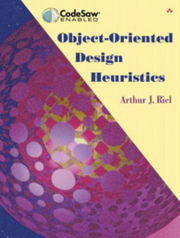Arthur Riel 1996
m (Reverted edits by Ebybymic (Talk); changed back to last version by Matthew Harward) |
|||
| (10 intermediate revisions by 3 users not shown) | |||
| Line 1: | Line 1: | ||
| − | + | [[Image:arthurRiel1996.jpg|thumb|left]] | |
| − | + | '''Title:''' Object-Oriented Design Heuristics | |
| + | |||
| + | '''Author:''' Arthur Riel | ||
| + | |||
| + | '''Year:''' 1996 | ||
| + | |||
| + | '''Publisher:''' Addison Wesley | ||
| + | |||
| + | '''Note:''' This book is out of print. | ||
| + | |||
| + | |||
| + | == Object-oriented Design Heuristics (Arthur Riel) == | ||
| + | |||
| + | This book contains a total of 60 guidelines and golden rules about good object oriented design. The rules are categorized into eight sections: | ||
| + | |||
| + | *Classes and Objects: The building blocks of the object-oriented paradigm | ||
| + | *Topologies of action-oriented versus object-oriented applications | ||
| + | *The relationships between classes and objects | ||
| + | *The inheritance relationship | ||
| + | *Multiple inheritance | ||
| + | *The association relationship | ||
| + | *Class-specific data and behavior | ||
| + | *Physical object-oriented design | ||
| + | |||
| + | Each rule is explained in detail in a section of the book and is usually accompanied by a real-world example. | ||
| + | |||
| + | Riel says that this book attempts to turn a list of subconscious rules acquired by developers into a concrete list backed up by real-world examples. He also notes that the heuristics are not hard and fast rules that always need to be followed but rather guidelines. However, some rules are much stronger than other because of the negative effect produced if they are not followed. | ||
| + | |||
| + | == See also == | ||
| + | * [[Riel's heuristics]] | ||
| + | |||
| + | [[Category: Resources]] | ||
Latest revision as of 03:10, 25 November 2010
Title: Object-Oriented Design Heuristics
Author: Arthur Riel
Year: 1996
Publisher: Addison Wesley
Note: This book is out of print.
Object-oriented Design Heuristics (Arthur Riel)
This book contains a total of 60 guidelines and golden rules about good object oriented design. The rules are categorized into eight sections:
- Classes and Objects: The building blocks of the object-oriented paradigm
- Topologies of action-oriented versus object-oriented applications
- The relationships between classes and objects
- The inheritance relationship
- Multiple inheritance
- The association relationship
- Class-specific data and behavior
- Physical object-oriented design
Each rule is explained in detail in a section of the book and is usually accompanied by a real-world example.
Riel says that this book attempts to turn a list of subconscious rules acquired by developers into a concrete list backed up by real-world examples. He also notes that the heuristics are not hard and fast rules that always need to be followed but rather guidelines. However, some rules are much stronger than other because of the negative effect produced if they are not followed.
